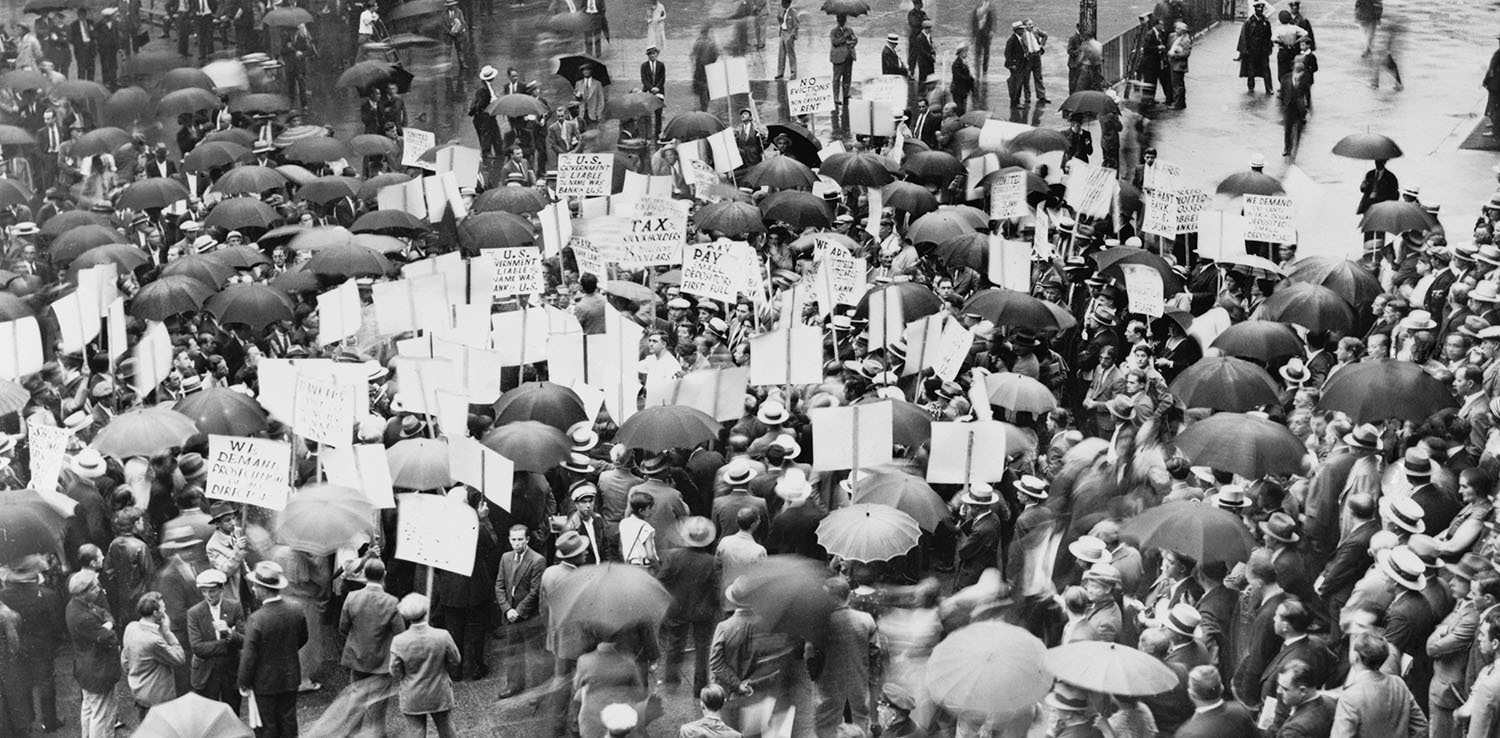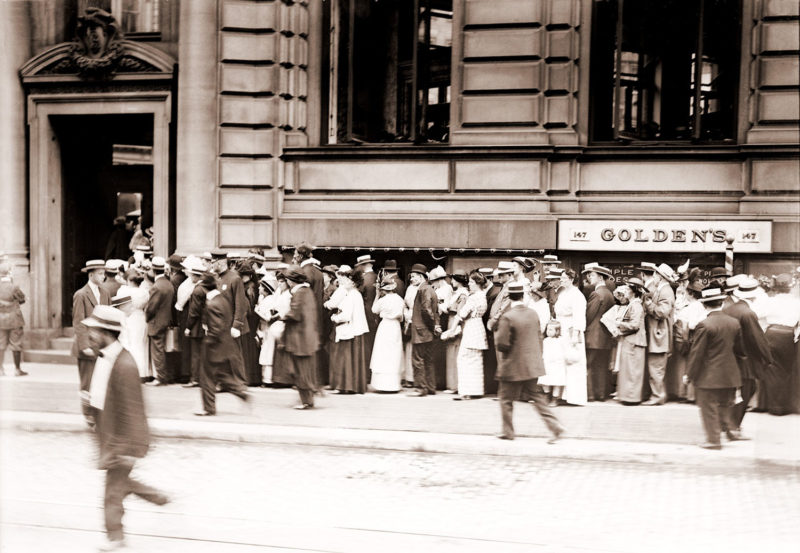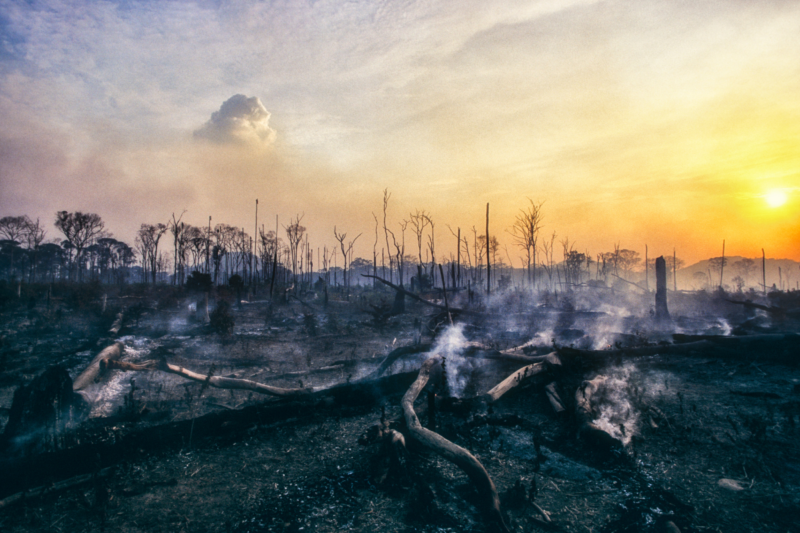

History of crises: cracking fears (2/2)
As the 21st century has left the belligerent 20th century behind, the economic system has become increasingly complex. Along the way, some crises have been terribly violent and devastating in their consequences; others have been anecdotal. With the help of 11Onze agent and historian Oriol Garcia Farré, we conclude this radiography of the great crises of human history.
Although the 20th century is a short century, its consequences continue to affect our daily lives. Historiography considers its chronological arc to span from the end of the First World War (1918) to the fall of the Berlin Wall (1989), although it could be extended to the attack on the twin towers in New York (2001). The intensity of events is such that it forces us to reflect on where we are going. This is why we have entered the 21st century with a host of transcendental questions to answer: the climate crisis, the production model, consumption, housing, the relationship with money, technology, freedom… Will we be able to find answers that benefit societies as a whole?
1929: The megacrash
There are historical facts… and then there is the historical FACT. And, for the contemporary world, this is it. It is the hinge that marks a before and an after. A concatenation of political, economic and social decisions that would end up leading the world into the abyss. Its causes and consequences have been studied by all the disciplines of the social sciences. And, even today, it is still taken as a reference to define whether an economic crisis will have a greater or lesser impact. We are talking about the US stock market crash of October 1929.
In the early 1920s, the US economy was based on a purely speculative model, which led to a significant gap between the real economy and stock market activity, which became increasingly worse.
Faced with the closure of European markets and falling agricultural prices, the US government and banks tried to react by providing substantial credit. These measures led to an abundance of short-term capital and speculation, especially from 1926 onwards. Unfortunately, the monetary authorities did not act in time to curb this unhealthy speculation.
So it was that, in early October 1929, there were upward trends in investment. But when the sell-off in stocks soared, panic set in on 24 October, and the same thing happened on Tuesday 29 October. The stock market crash was inevitable due to the zero demand for shares, and a global crisis of biblical proportions was unleashed. Apocalyptic. Far worse than the English crisis of 1720, as it affected the whole world.
In 1932, some 5,096 banks went into receivership. Their collapse led to the bankruptcy of numerous companies, which saw stocks of goods accumulate, causing prices to fall sharply, especially in the agricultural sector. Finally, the decline in economic activity led to a galloping rise in unemployment.
To stem the haemorrhaging of the financial system, from 1931 onwards, the massive repatriation of US capital from Europe – which had helped finance the post-war period of the First World War – led to the collapse of European banks, mainly Austrian and German. From this point on, the story is well known. The whole world was plunged into a long apocalyptic night.

“The EUA stock market crash of October 1929 is the hinge that marks a before and after. It is still used today as a reference to define whether an economic crisis will have a greater or lesser impact”
1945: After the Apocalypse
60 million dead. This is the total cost in lives that humanity had to pay for the Second World War. The destruction of cities, villages, infrastructure, landscapes, material goods, industry… was gigantic. Disproportionate. The economic cost has been put at $200 billion in 1947 dollars, equivalent to some three trillion dollars today. The devastation of Europe and parts of the Far East, such as Japan, was such that the whole world experienced a profound and painful post-war period. There was an urgent need to begin to rewrite history. But what were the options?
As had happened in the past in the resolution of war conflicts, for example at the Congress of Vienna to redraw the map of Europe after Napoleon’s defeat or at the Treaty of Versailles after the First World War, the meeting of the victors was imminent. The future had to be planned, and so it was that the Allies met in the German city of Potsdam in the summer of 1945.
The agreements had a relative resolution, as they took shape over the following decades. Even so, the victors acted more as notaries of the new geopolitical situation than as the brains behind the new global realignment. Thus, the Potsdam Conference clearly visualised the division of the world into two blocs. Two political, social and economic models that would provoke several low-intensity armed conflicts over the next four decades.
The technological breakthrough of World War II would take mankind into outer space, to the moon and beyond, but it also led to the development of the atomic bomb as a weapon of mass destruction. This threat has been used ever since as an instrument of political pressure.
1973: If you play with fire, you can get burned
After World War II, the growth model adopted by the Western world, including Japan, was based on massive oil consumption. Since then, the Western economy has been heavily dependent on this limited resource. And it is well known that, if you want your economy to function properly, you have to know your friends and be consistent with your actions.
On October 6, 1973, Yom Kippur or Day of Atonement for Sin, the most important Jewish holiday, Egyptian and Syrian troops launched a major offensive against Israel to regain the Sinai and Golan Heights lost in 1967. After three weeks of fighting, the Israelis, with the support of the United States, succeeded in re-establishing their hegemony in the area.
Then, the Arab OPEC countries, i.e. those who controlled the oil, not happy with the situation, decided to embargo the oil of all Western countries in retaliation against those who had supported the conflict. The measure caused an exorbitant increase in the price of oil – from $2.90 to $11.90 – which led to a sharp rise in inflation throughout the world.
For the U.S. economy, the main economic engine of the West, the foreclosed meant a drastic slowdown in the economy, with a consequent increase in unemployment. In fact, the market had already been showing worrying signs of deceleration for months, and this was compounded by President Nixon’s decision to unpeg the dollar from the gold standard. Thus, with the end of the Bretton Woods system, the economy plunged into the abyss.
The foreclosed lasted six months and generated major energy supply problems, as well as a period of low economic growth worldwide. Some countries, such as France, sought other sources of energy, such as nuclear power, while the United States and Canada opted for waste wood cream.
The current situation forces us to ask ourselves whether this model of unbridled energy consumption, which has been the main source of growth in the Western world for decades, can continue to be sustained. The climate crisis is a very palpable reality, and we must work to find real solutions that promote a much more sustainable production and consumption model.

“Our present forces us to ask ourselves whether this model of unbridled energy consumption, which has been the main source of growth in the Western world for decades, can continue to be sustained. The climate crisis is a very palpable reality”
1988: The system collapsed
If they wanted to survive, they had to take a step forward. In order not to collapse, they had to carry out a very relevant and millimetrically calculated reform of the system implemented in 1917. The person in charge of carrying out this gigantic challenge was a young lawyer, elected first secretary of the Communist Party three years earlier, and in whom the old guard had placed all its hopes. In the early 1980s, the USSR was facing a major historical crossroads: how was it possible that, as the world’s second industrial power, it was unable to produce enough consumer goods and foodstuffs to meet the needs of its population?
The situation had become more than evident since the 1970s, when the Soviet system proved ineffective due to centralized planning. Added to this was the enormous weight of military spending, a brutal technological backwardness and a poor quality of work due to an unmotivated workforce. Moreover, all this was managed by a single party made up of old glories!
The economic and political reforms promoted since 1988 by the first secretary of the Russian Communist Party, Mikhail Gorbachev, were aimed at readjusting the system without destroying it. This readjustment implied a liberalization of the market and an opening of foreign trade. Sooner or later, however, it was known that both options would lead to a democratization of society. The explicit acceptance of the transition from a centralized, planned economy to a market economy put an end to more than 70 years of the Soviet experiment, initiated in that distant October Revolution of 1917.
Despite all the measures implemented, Perestroika failed. The weakening of central power, the resurgence of nationalism and the emergence of major internal conflicts hastened the end of the Union of Soviet Socialist Republics in less than three years. A period of serious crises in the former territories of the USSR followed, many of which persist even today, as evidenced by what is happening in Ukraine, where historical motives and geopolitical interests stemming from the Cold War are mixed.
2001: Corralito, when the money went up in smoke
And they wanted to touch the sky. In the early 1990s, Argentina had implemented the Convertibility Plan, which consisted of maintaining a fixed exchange rate of one peso per dollar (1:1). This measure was intended to end hyperinflation and stabilize prices through economic growth. In this way, it sought to reduce the fiscal deficit after a period of recession with the consequent indebtedness of the State.
At the beginning of 2000, Argentina’s external debt caused by convertibility started to become increasingly important, which led to an exponential increase in the fiscal deficit. All this began to generate distrust among investors, both internal and external, who, moved by the rumour of a possible suspension of payments by the State, began a massive flight of capital.
The drama of it all began on a fateful December 3, 2001, when Argentina faced a restriction on the freedom of account holders to dispose of cash deposited in banks. This corralito was decreed by the President of the Republic to stabilize the economy, which had the opposite effect.
What had the State done in an extreme situation? Well, it asked for a loan of 40 billion dollars from the International Monetary Fund (IMF) in 2000. And when it ran out, what did it do? Well, it asked for another loan of 30 billion dollars from the IMF in 2001. Thus, in November 2001, Argentina’s public debt amounted to almost $145 billion. That is, 150% of its GDP. To give an equivalence and to be aware of the magnitude of the tragedy, Western economies at the time were close to 50% indebtedness of their GDP. One year later, Argentina abandoned convertibility [1:1.45], devalued its currency and declared bankruptcy.
The unemployment rate was close to 35%, the risk premium exceeded 5,000 points, inflation reached 52% and 60% of the population would fall into poverty in the following years. Faced with this dramatic situation, major riots broke out in the main Argentine cities. And what was the reaction of the State? A forceful and indiscriminate repression. The aftermath of that crisis still lingers in Argentine society, and the fear of another “corralito” still exists in its memory. It is estimated that in 11 months almost 25,000 million were volatilized. In 2010, Greece experienced a situation similar to the “corralito” in Argentina.

“From 2008 onwards, the reality was different: a real disaster. The financial system had developed and marketed products such as subprime mortgages, preference shares and futures, and would end up being swallowed up by its greed”
2008: A mortgage is worth so much?
I’m sure this story rings a bell: “I had a small flat that my parents left me as an inheritance. I sold it. With the proceeds, I bought a piece of land that I mortgaged to build my dream house, because I had always wanted to live outside the city. This financial operation left me some savings.
One fine day, I received a call from my advisor, the one from my old bank, who offered to invest my savings in the development of a luxury single-family housing development near the sea. It sounded like a safe investment. As it was guaranteed by the same bank, I trusted. Then, my advisor told me, without being signed anywhere, that with this operation I could live without worrying about money for the rest of my life.
It was then that I was encouraged. Because of the confidence that the operation generated in me, because of the personalized management of so many years doubled and, to put it clearly and in Catalan, to earn more money, I added to the savings an extension of the mortgage of the house. I also asked for something more to build a swimming pool, renovate my car and even went on holiday to the Fiji Islands.
But one fateful Monday the advisor called me to tell me that the promotion had been a failure and that, therefore, I had lost everything. From that moment on, my monthly mortgage payment increased by 800%.”
This was the illusion with which the financial system, led mainly by the banks, made many people believe that it was possible to live in a happy world. However, from 2008 onwards, the reality was different: a real disaster that, added to other products that the financial system developed and marketed, such as subprime mortgages, preferred securities or futures, would end up engulfing the greed of that same system.
Countless studies, articles, interviews, interviews, reports, documentaries, and films have explained ad nauseam the global financial crisis of 2008, which had its origins in the marketing of a set of real estate bonds put on the market by major U.S. banks. Initially, these real estate bonds offered investors a high return with low risk. This soon led to these products becoming the instrument of choice among banks.
The bonds were backed by a pool of mortgaged homes, with regular current payments by the owners. In this phase, the interest rate was kept low. So far, a normal product of the 2000s offered by banks. But things started to change in 2006, when some smart guy found a way to maintain the steady flow of capital generated by these bonds.
Therefore, the trick was to expand the market and start offering mortgage loans left and right, without checking either the regular income or the credit history of the buyer. Surely, the smart guy from before already knew that this had a limit, because houses are finite and so are regular payers. Because what happens when you don’t pay? The system can assume it, and what happens when two do not pay? The system can continue to assume it, and what happens when many do not pay? That’s when the problem appears. Everything falls apart. The rest is common knowledge.
In the mid-1980s, the Japanese economy had already gone through a similar process of revaluation of financial and real estate assets, which experts had considered one of the biggest speculative bubbles in modern history. In 2006, no one looked back. Only a few took note. If you are interested in how they did it, you can’t miss the film ‘The Big Short’ (2015).

“It will be vital to prepare, to build a strong financial culture, in community and with freedom, so as not to fall back into the abyss, for what is to come”
2022: Towards a friendly symbiosis
Perhaps he was too bold, and time has proved him wrong. It was in the context of the fall of the Berlin Wall in 1989 that the American political scientist Francis Fukuyama published his famous and controversial article on “the end of history”.
The thesis was that, with the end of the Cold War, history had come to an end because global ideological uniformity had been achieved. This assertion was based on the idea that it was liberal democracy, represented by Western capitalism, that had been able to bring down the communism of the Soviet bloc and would therefore be able to stop other wars and revolutions in the future. But had history really come to an end?
The reality of our present forces us to look to the past to understand what is happening to us. And the current debate pivots on the confrontation of two models, a priori antagonistic, that seek a friendly symbiosis, and that find their hyperbole in two dystopian novels written precisely in the twentieth century.
On the one hand, we have the model described so well by the writer Aldous Huxley in the dystopia ‘Brave New World’ (1932), in which he describes a world where people are controlled by means of entertainment, drugs and deformed emotional relationships. On the other hand, the model described by George Orwell in his dystopian novel ‘1984’ (1949), where he describes a world ruled by an elite that, through language and mind manipulation, watches over us and punishes us with violence.
Will the fourth industrial revolution, with all this hyperconnectivity, make possible the coexistence of ‘Brave New World’ and ‘1984’ in the same matrix? Are Russia and China the realization of this symbiosis? What will happen to the West, which is moving towards a ‘Don’t look up’, as in the film of the same name?
We have reached the end of this economic radiography, where we have analyzed the crises of the last centuries from specific moments. And, as we have approached the present, we have abandoned the historical analysis with which the social sciences interpret the evolution of the generations to become opinionative of the present. The closer we are to what is happening to us, the more we lose the perspective necessary to understand what is happening with a critical eye. We are not yet capable of perceiving the multidimensionality of the historical present, because we lack the temporal posture.
Many of the current developments are still in progress, and many others have not even begun. What does the future hold? We do not know. Yes, we do know what happened in the past, if we know that there are questions that history helps us to answer. And, above all, if we know that it will be of vital importance to prepare ourselves, to build a solid financial culture, in community and with freedom, so as not to fall back into the abyss, for what is to come.
11Onze is the fintech community of Catalonia. Open an account by downloading the app El Canut on Android and Apple and join the revolution!





Molt bona explicació Oriol👏👏👏 encara que no sé quina novel•la em fa més por, la de Huxley o la Orwell😨, entre ambdues novel•les tens alguna favorita?gràcies per l’article👌
Gràcies Jordi pel comentari! Sempre m’ha agradat més en Huxley! Seguim a La Plaça!
Història de les crisis =història de la vida. Hem
d’intentar sempre buscar el màxim benestar econòmic i emocional pel conjunt de la societat, però també hem d’aprendre a viure amb problemes, perquè tal s’ ha dit per aquí, les crisis, d’ una mena o altra són cícliques.
Cert, Mercè és llei de vida i necessàries per evolucionar, però d’intentar que aquestes no s’ho emportin tot per endavant. Gràcies pel comentari i seguim a La Plaça!
Doncs sí, sempre ha sigut així… Moltes gràcies pel teu comentari, Mercè!!!
👍👍
Gràcies, Joan! Seguim a La Plaça.
Bon article!
Moltes gràcies, Joan per llegir aquest dens article! Desitjo que t’hagi agradat i hagis après una mica més! Ens veiem per La Plaça!
Ok 👍
Gràcies, Josep! Ens veiem per La Plaça.
Gran recull històric. Bona feina. Però avui altre cop estem parlant de dèficit, atur, rescats, embargaments … Tal com apunta, Quin futur ens espera?.
Gràcies, Pere per la teva reflexió. Tot plegat és inherent del sistema econòmic al qual estem adscrits. Els reajustaments constants fan pensar que estem davant d’un nou període convuls. El futur ningú el sap encara que el podem predir coses que succeiran. Seguim a La Plaça.
Tot és cíclic, però malauradament, és molt cert que ara mateix tenim una etapa força complicada pel davant… Moltes gràcies pel teu comentari, Pere!!!
👏
Gràcies, Daniela per seguir-nos i llegir-nos. Ens veiem per La Plaça!
Gràcies, Daniela!!!